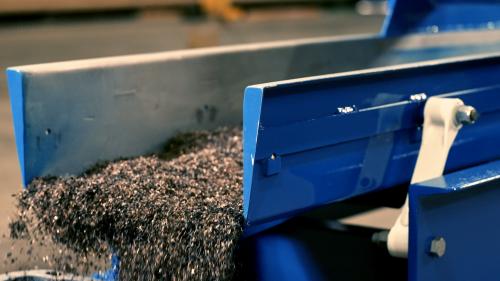What is bulk material handling, and why do we need it? Well, first off, let's define dry bulk materials (in the form of powders, flakes, granules, pellets, fibers, crystals, etc.) supplied in bulk to processors of a wide variety of consumer and industrial goods. Dry bulk solids go into essentially anything and everything, from the food and beverages we consume to the plastic containers we buy them in. They're in our cars, roads, ceilings, walls, floors, furniture, and even our electronic devices!
The appeal of buying anything in bulk is the economy of it, but with this comes the challenges of storing, moving, and containing the material safely and efficiently. Ideally, a bulk material handling system will address all of these issues through a smooth, clean, and continuous mechanical process, maximizing productivity and minimizing liability.
Key functions of a bulk material handling system
The endgame of bulk material handling is to ensure mass quantities of loose particles get from an origin to a destination without getting stuck or lost, as these outcomes can be costly and potentially damaging to the overall operation.
Storage
Dry bulk often begins (unloading) or ends (filling) each leg of its processing journey from an FIBC (flexible intermediate bulk container) bulk bag — aka big bags, tonne bags, super sacks, or jumbos — flexible industrial containers designed to transport, store, and dispense material by the ton.
Alternatively, dry solids can be stored in boxes (aka octabins), rigid bins, hoppers, silos, stockpiles, or stockyards, depending on the material, the volume present, and the stage of processing.
Movement
As mentioned previously, the primary function of a bulk material handling system is continuous and regulated movement, which is accomplished by conveyors, feeders (chutes for uptake), and hoppers (for deposit). There are several types of conveyor systems used in the dry solids handling industry, including vibratory, belt, screw (auger), pneumatic (vacuum), chain, and bucket elevator.
Conveyors may be oriented horizontally, vertically, or on an incline as the material moves between processing areas. More complex setups may integrate two or more conveyor types, with additional mechanisms to divert material for storage and/or blending. It is also common to implement sieves, shakers, and vibratory components in conveyor systems to prevent flow problems.
Containment and sanitation
Depending on your specific bulk material, certain sanitation processes may be needed to prevent contamination during your operation. For example, fans and dust collectors help contain airborne particulates created during processing for finer materials akin to powder. Some conveyors may require a thorough washing in order to align with sanitary regulations and prevent future risks of contamination.
What bulk material handling equipment do I need?
The main factors to consider when determining what kind of bulk material handling equipment you need for your operation are:
- What are you processing? Are the particles large or small? What shape are they? Do they pack together tightly or loosely? Have specific temperature or pressure requirements? Are they hazardous? Fragile? Edible?
- How much? If you are handling large volumes, ideally you will have a larger, more powerful system to process it.
- Where are you processing it? Of course, the location and size of your processing site or facility may limit the kind of system that can be accommodated.
Bulk handling solutions from ETS
Erie Technical Systems offers standard or customized bulk handling solutions for manufacturers of all sorts and sizes. Our systems are designed modularly in order to adapt to each customer's individual circumstances.
Bulk unloading equipment
If you are discharging materials shipped in bulk bags, we recommend our UltiMAX™ Bulk Bag Unloader. For rigid containers, go with our Bulk Container Dumper. Additional pieces you can add to your unloading setup include the Bag Break Station (for containment of harsh airborne particles) and Bulk Bag Conditioner (for breaking up solids that settle or set up during shipping).
Bulk filling equipment
Our bulk filling equipment options are diversified to address any processing situation, from simple to complex. For manufacturers with lower packing rates, the DustMAX™ bulk bag holding frame could be sufficient. Our popular ValuMAX® Bulk Bag Filler is a great solution for mid-sized operations with higher throughputs, and can be configured manually or automatically. For larger and more elaborate operations, we can integrate our high-volume DensiMAX™ fillers with pallet handling conveyors and PalletMAX™ pallet dispensers into custom-engineered SysteMAX™ packaging lines.
Bulk transfer equipment
At the heart of our bulk transfer equipment line are the FlexMAX® Flexible Screw Conveyor and VibraMAX™ vibratory conveyors and feeders for moving food, chemicals, grains, or other dry bulk solids horizontally or vertically, with designs to efficiently move up to 250 tons of bulk material per hour. Our SpiralMAX™ vibratory spiral elevators are a smart solution for moving material vertically when floor space is at a premium.
No matter what your industry, at Erie Technical Systems, we are confident in our ability to provide a standard or custom bulk material handling solution catered to your application. Do not hesitate to reach out; we are eager to collaborate.

